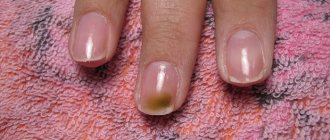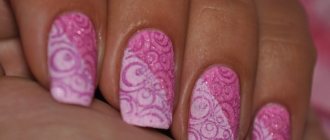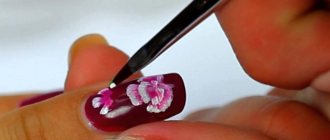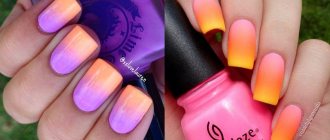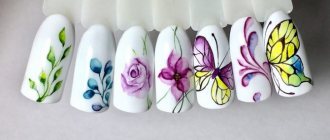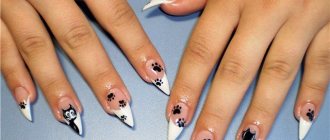Beautiful and well-groomed nails are the dream of every girl. They are ready to do anything to be attractive right down to their fingertips. Professional care, polishing, extensions, and expensive skincare cosmetics are used. But all the efforts and expenses will be completely in vain if suddenly the nail plates become ribbed.
If you notice that your nails have acquired an unnatural wavy structure, then it’s time to think about the reasons for this deviation and how to eliminate it.
What does this mean and what do nail plates with transverse and longitudinal waves look like?
Such a deformity can occur in any person, regardless of gender and age. Most often, the thumbs of the left or right hands suffer from the problem. If the pathology is associated with internal disorders, then as it develops it will affect the nail plates on other fingers. There are two types of waviness in nails:
- longitudinal (it is also called vertical, the waves go from the cuticle to the free edge of the nail, deformations are difficult to notice on the nails, significant longitudinal waves signal the presence of serious diseases);
- transverse (is a symptom of a disease; in medical practice such deformations are called Bo’s furrows; transverse waves are always more pronounced than longitudinal waves, accompanied by looseness of the nail and a change in the shade of the plate).
Important! Transverse waves on the nails are always a sign of the presence of a disease in the body. Therefore, if a deviation is detected, immediately contact a specialist for diagnosis.
How are they formed?
Bo's transverse grooves on the nails are formed when the growth of the nail plate is temporarily disrupted. The living growing layer of the nail is found in the nail matrix, which is located under the cuticle. We see only a small zone of it - a white semicircle at the base of the nail, which is called the lunula or lunula.
When the supply of nutrients to the matrix decreases, the growth of the nail plate stops, and deformations in the form of characteristic depressions remain on the nail.
By the distance from the cuticle to the Beau-Reil line, you can determine when an injury or illness occurred that caused the deformation of the nail. The nail plate grows slowly, by 3–5 mm per month, so Beau’s lines do not appear immediately after exposure to a negative factor, but after 2–3 weeks. In order for the indentations to be clearly visible, the nail must grow. First, the dents appear on the lunula, and then move forward to the free edge.
The number, width, and depth of lines depend on the cause of disturbances in the matrix.
Endocrine and hormonal disorders
Nails begin to become wavy due to metabolic disorders in the body. This can be caused by poor nutrition, dysfunction of internal organs and/or systems, and bad habits. Very often, metabolic disorders are triggered by metabolism.
Changes in hormonal levels also cause changes in the surface of the nail plate. In most cases, this can be caused by a disruption in the production of thyroid hormones, a sharp change in their levels in the body.
How to get rid of unevenness
Transverse lumpy formations and dents.
Treatment of such a problem is possible only after the reasons why nails grow in waves have been identified. When infected with fungal infections, the healing process can be long.
If such an unpleasant manifestation is caused by diseases of the internal organs, then a thorough examination by a specialist is necessary. To complete the healing process, the necessary medications will be prescribed - restoring impaired metabolism, iron deficiency or, if necessary, hormone levels.
If the defects are caused by cosmetic reasons, measures are required to transition to a healthy lifestyle and start treating your fingers more carefully. You should also avoid exposing deformed nails to chemically active substances and dirt.
An experienced cosmetologist can polish the nails if their ribbing is not strong.
Why does deformity appear in women and men?
There can be many reasons for the appearance of such deformation. The problem arises not only in the presence of any diseases, but also after an injury to the nail plate or an unsuccessful manicure.
Mechanical damage
Injury to the nail plate often leads to the appearance of longitudinal waves on the nail. Injuries include, for example, a purulent inflammatory process (felon), damage to the cuticle or nail plate during an impact, etc.
If the injury is not too serious, then you just need to wait until a healthy nail grows. In case of purulent inflammation, you will have to consult a doctor, he will prescribe you the necessary medications for external use, which will help relieve inflammation and restore the nail.
Usually, after a healthy nail grows out, the waviness disappears.
What is missing and what are the problems in the body?

In this case, the fight against unpleasant waviness on the nails will be more difficult.
- Firstly, it can be difficult to determine on your own what exactly is happening to the body and what element it is missing.
- Secondly, treatment may be delayed due to the complexity of diagnosis. Malnutrition can lead to deformation of the nail plate (both longitudinal and transverse).
In order for the nail to form correctly, it needs several important connections:
- B vitamins;
- vitamin A;
- calcium.
Thinning of the nail and the appearance of transverse or longitudinal ribbed stripes on it indicates that some elements are missing in the body or are not absorbed normally (which, in fact, also depends on a sufficient amount of minerals).
Ideally, diet and taking additional medications that can compensate for the deficiency of elements can help.
Note! In such cases, you should not self-medicate. Contact your doctor, carry out the appropriate diagnostics and consult with him about vitamin or mineral complexes that are suitable for you.
But not only a lack of minerals can lead to changes in the texture of the nail. Malfunctions in the body also affect the health of the nail plates:

- Hormonal disbalance. If the thyroid gland does not work properly in the body, growths and deformations may appear on the nail plates. A ribbed surface is one of the possible deviations that can occur with hormonal changes. It is best to consult an endocrinologist for advice (especially if you have additional symptoms indicating problems with the thyroid gland - acne, fragility and hair loss, swelling, sudden changes in weight, etc.).
- Constant stress. Being in a constant state of stress, which gradually develops into depression, significantly affects the functioning of all body systems. Nails are also subject to regular stress. They can affect the shape of the nail plate and its texture, as well as cause the development of third-party diseases that also affect the health of the nails.
Diseases
Various fungal infections (mycoses) can cause changes in the structure and shape of the nail. Their insidiousness, first of all, is that at first they affect only the top layer of the nail plate, so it is almost impossible to notice the disease at an early stage.
But gradually the fungus will progress, affecting the deep layers of the nail tissue and causing deformation of the plate. The thickness of the nail gradually begins to increase disproportionately, transverse ribbing appears, and the color of the nail changes.
Diagnosis by nail hole
Holes or lunulae are light areas located at the base of the finger. They, like nails, indicate health problems.
The hole has become thin or disappeared completely:
- The little finger hole is the very first harbinger of the state of the cardiovascular system and metabolic disorders in the small intestine. It is possible that hypertension is developing and it is time to control the pressure. Gastrointestinal symptoms appear (bloating, diarrhea, pain). By the way, over the years, the hole on the little finger disappears for many (I no longer have it on both hands).
- The ring finger, next to the small one, will show the state of the endocrine system. Often during menopause, the hole begins to disappear. It is necessary to regularly check thyroid hormones, the lymphatic system, and women should visit a gynecologist.
- The middle lunula disappears. In this case, heart problems begin, which means the vascular and circulatory system suffers.
- The index finger tells about the condition of the large intestine, pancreas, liver, and gynecological diseases.
- The lunula of the thumb shows the condition of the spleen, lungs and the health of brain activity.
Large
Normally, it should be about 25% of the entire surface of the plate.
If the holes occupy a third of the entire plate, then they are considered large. This is a reason to diagnose the condition of the heart and blood vessels. In hypertensive patients it grows on the little finger.
Pay attention to irregular heart rhythms or other abnormalities. Weakness of the heart muscle has a sign of unnatural enlargement of the holes on all fingers
Large holes are often observed in people who play sports professionally. They also increase in size after suffering stress.
Little ones
If the lunulae barely reach the cuticle, then they are considered small. Reduced in size are:
- low blood pressure;
- problems in the circulatory system;
- weak immunity;
- metabolic disorder;
- with deficiency of iron and vitamin B12;
- diabetes mellitus visually isolates the holes from the common nail plate with a transverse stripe.
- lung problems especially in heavy smokers.
Can not see
Normally, the sockets may not be visible in children. Over time they should appear. Sometimes their absence is a consequence of the physiological characteristics of the nail structure. In this case, there is no need to panic.
Their sudden disappearance should be a cause for concern. As medical observations show, this effect occurs when there is a malfunction:
- thyroid gland;
- iron deficiency anemia;
- vitamin B12 deficiency.
Color change
You need to pay attention to the color of the holes; normally they are white, lighter than the skin. Color changes indicate various disorders:
- Gray - speaks of diseases of the digestive system.
- Purple is a sign of impaired blood supply to tissues and organs. Frequent headaches and dizziness.
- Red color is a marker of lung diseases. The sockets turn red in people who lead a sedentary lifestyle.
- Black. It signals that the body is poisoned by heavy metals.
Sometimes lunulae turn blue in the cold. If they turn pink again in the warmth, there is no cause for concern.
Uneven surface of nails in children
Wavy fingernails can also be present in a child, the reasons may be the following:
- The Candida microorganism entered the child’s body through the consumption of poorly processed vegetables and fruits.
- Carbohydrate imbalance due to a lack of vitamins A and B in a child.
- Scratches and peeling of the skin at the edges can provoke an inflammatory process due to infection.
- Colds, pneumonia, and lichen sicca can also affect the structure of a child’s nails.
The nail plate of children differs from that of adults in structure. In a child it is thin and easily damaged. Many children bite their skin, causing hangnails. A child’s cuticle is hypersensitive, and often, when damaged, serves as a favorable environment for the proliferation of yeast parasites. Adults need to disinfect the baby’s nails with an antimicrobial solution, and wash their hands with antibacterial soap after a walk. It is necessary to regularly wipe your hands with disinfectants.
Proper care
With regular and healthy care you can maintain the beauty of your nails. Several rules must be followed:
- Professional manicure. To do this, it is necessary to properly file, trim the cuticle, carefully eliminate and treat cracks, damage to nails and skin.
- Protecting nails from toxic influences. For this purpose, gloves are used, oils are used to strengthen varnishes.
- Maintaining hygiene. An individual manicure set is used and an antiseptic is used.
Proper care requires effort to achieve the desired result. Regular procedures and hygiene rules help protect against aesthetic defects and unpleasant ailments.
Treatment

The easiest way to cure waviness of the nail plates, which was caused by mechanical damage. For example, after injuries, cuts, chips, etc. You just need to wait a while for a new nail to grow.
If the deformation occurs after a poor-quality manicure, then seek advice from a more experienced nail service specialist. Don't forget that the following plays an important role here:
- nail care;
- regularity of their processing;
- accuracy when working with cuticles;
- proper baths, etc.
If you do a manicure at home, pay attention to the following recommendations:
- be sure to disinfect all manicure instruments before each procedure;
- purchase manicure tools only in specialized stores and make sure that they are of high quality;
- do trimmed manicures only with special scissors, which should also be used to trim burrs;
- remove varnish with high-quality solutions without acetone;
- Use nourishing and moisturizing hand products daily that contain vitamin complexes.
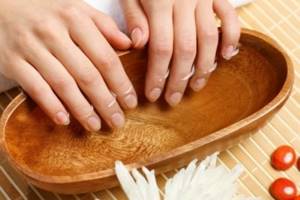
Periodically make herbal hand baths with antiseptic compounds (for example, calendula, sage, chamomile and others). Paraffin wraps have a good effect on the nail plates and skin of the hands. They can also be done at home if you have special equipment. Regularly following all the above recommendations will help get rid of waves on your nails, but only if the cause of the deformation is hidden in poor-quality manicure or improper care of the nail plates.
If the deformities appear due to regular stress, then ask your doctor to prescribe you medications that relieve nervous tension (for example, Afobazol, Tenoten, etc.).
If you are deficient in vitamin A, adjust your diet. Vitamin deficiency can be replenished with the following foods:
- carrot;
- greens of any kind;
- broccoli;
- meat products;
- tomatoes;
- seafood and fish;
- liver;
- dairy products;
- eggs;
- Bell pepper;
- potato;
- pumpkin;
- melon.
To replenish B vitamins, you should include the following foods in your diet:

- buckwheat grain;
- liver;
- nuts of all varieties;
- sprouted grains;
- spinach;
- seafood;
- various types of fish;
- legumes;
- cabbage (cauliflower, broccoli);
- Rye bread;
- dairy products.
If the reason why you have hypovitaminosis is the inability to properly absorb vitamins and minerals, then the doctor will prescribe you vitamin and mineral complexes that will help restore the balance of macro- and microelements in the body.
If, during the diagnosis, it turns out that the cause of the nail deformation was a fungal infection, then, first of all, it is necessary to establish the type of pathogen. In case of bacterial infection, local antibiotic drugs (gels, ointments, lotions) will be prescribed. In case of fungal infection, antifungal drugs are prescribed.
The situation is more complicated with hormonal disorders. Usually in this case complex treatment is prescribed. It can be long and affect third-party systems of the body. The same applies to other systemic diseases that cause changes in the texture of the nail. In these cases, consultation with a specialized doctor (gastroenterologist, cardiologist, endocrinologist and others, depending on the type of disease) is necessary.
Vitamin therapy
If nails or toenails grow in waves, doctors recommend using vitamin therapy, as well as learning to eat a balanced diet. Nutritionists advise eliminating flour and fatty foods from your diet. Vitamins found in foods are also useful:
- Vitamin B. Eliminates inflammation, accelerates tissue healing. Black currants and olives are rich in them.
- Iron. Transports oxygen to tissues. The component is present in poultry meat, zucchini, and berries.
- Fluoride and vitamin C. The components are needed not only for nails, but also for the normal condition of teeth, bones, and hair. Vitamin C strengthens the immune system. The component is rich in citrus fruits, nuts, tomatoes, and chicken eggs.
- Selenium. Eliminates layering and brittleness of nails, provides natural shine. Onions, oatmeal, buckwheat and other foods are rich in selenium.
If your toenails or fingernails grow in waves, then these products must be included in your diet. Proper and balanced nutrition allows you to quickly get rid of deficiency.
Prevention
In order to avoid any changes in the texture of the nail plates, you need to maintain their health with regular caring procedures. The following recommendations must also be observed:

- When doing a home manicure, file your nails at a right angle. Do not tear off hangnails and cuticles with your hands, do not let your fingers bruise and become inflamed.
- Since nail plates are capable of absorbing everything that falls on their surface, try to prevent your nails from coming into contact with household chemicals and other caustic compounds. Avoid high humidity.
- Protective gloves should be worn when working around the house.
- Take significant breaks between applying decorative coatings.
- Regularly use nourishing compositions for nails: creams, oils, gels, take baths with herbs.
- If you do not have sufficient knowledge about manicure, then it is better to entrust it to an experienced master in the salon.
- Be sure to use a base coat before applying a color coat of varnish.
- Inspect your nails periodically; at the first symptoms indicating the presence of diseases, contact a specialist and begin treatment.
Folk recipes
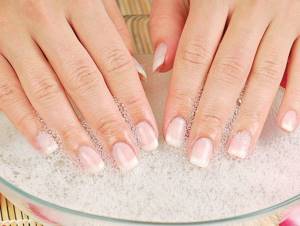
Folk recipes are widely used to help hands and restore beauty. The most effective and common recipes:
- Applications made from unrefined oil .
- Oatmeal mask made from flakes. You will have to apply an application of oatmeal for half an hour. Then rinse with running water.
- Tomato juice for baths. Keep for at least 20 minutes.
- Healing baths. Take 4 glasses of warm water, dilute sea salt: two tablespoons, add four drops of lemon oil or iodine. Use as a bath three times a week for a course of 60 days.
- It is also useful to do baths with medicinal herbs and plants . For example, duma bark, calendula, chamomile and others.
Elimination of unevenness with manicure: nuances of the procedure
A properly done manicure will help you disguise existing unevenness. However, it can only be done with the permission of a doctor and in the absence of serious injuries, inflammation or infectious diseases.
How to disguise wavy stripes on nails:
- Use only pastel-colored varnishes. You can choose compositions with small sparkles or pearlescent shimmer.
- Be sure to apply a base coat before applying your chosen color of polish.
- As an alternative to classic varnishes, you can choose gel polish (it is better to entrust such a manicure to a professional with special equipment).
- Use medicinal varnishes and leveling coatings when working.
- Perform a manicure according to all the rules, i.e. disinfect tools, use special scissors or softening compounds to remove cuticles, and take care of personal hygiene.
- You should not use brightly colored varnishes, as they will only highlight the uneven surface of the nail.
Wavy stripes on the nail plates can appear in both women and men. There are many reasons for the development of such a deviation. Some of them are associated with external factors (for example, injuries or poor-quality manicure), and some with internal ones (diseases of the endocrine system, stress, fungal infections, gastrointestinal diseases, lack of vitamins and minerals, etc.).
Whatever the reason, do not be lazy to consult a doctor for advice. The doctor will help not only establish a diagnosis, but also choose the correct treatment for such a deformity.
Oils
To moisturize and restore wavy nails, use base and essential oils. They can be bought at the pharmacy. Effective are:
- coconut;
- almond;
- olive;
- castor;
- burdock;
- apricot;
- avocado.
Esters that help include lavender, rosemary, lemon, grapefruit, and tea tree. Base oils enriched with essential oils are rubbed into the nails for a few minutes in the evening. Then cotton gloves are put on top. The product is left overnight.

You can also prepare an oil bath. Need to:
- mix 3 tbsp. l. olive, almond and avocado oils;
- add 5-6 drops of tea tree oil;
- heat in a water bath;
- lower your fingers for 15 minutes;
- then rinse off and treat your nails with nourishing cream.
A mixture with iodine also helps. For this:
- olive oil (1 tbsp) mixed with the same amount of lemon juice;
- add 3 drops of iodine;
- the composition is mixed.
A cotton pad is moistened with the mixture and rubbed into the nails. After a few minutes, rinse with water. You can use oils every day, which has a positive effect on the skin and phalanx of nails.
It is recommended to go only to professional manicurists and not to cut the cuticles yourself. It is better to use a protective base coat before using colored varnish.
Kinds
- Irregularities. The grooves attract people's attention. Diagnostics allows you to determine the cause that led to the deformation. Longitudinal grooves not only spoil the appearance, but also indicate a health hazard. The ribbed plate should not cause concern only in old age, since strong changes have occurred in the body. If the defect occurs at a young age, then you need to see a doctor. Don't hide it with nail polish.
- Waves. This deficiency indicates that the body's systems are not functioning properly. The defect appears when one completely abstains from meat. If, in addition to transverse waves, peeling is noticeable, then this indicates a fungus. There is no need to panic; the fungus can be easily treated. With the help of specialist consultation and simple procedures, it will be possible to eliminate the pathology.
- Lumpiness. In addition to irregularities, there may also be bumps. In this case, a doctor’s consultation and treatment are required. Usually the deficiency appears from a deficiency of minerals and vitamins, hormonal imbalance.
Often the nail grows in waves when cosmetic procedures are performed incorrectly. This is also associated with non-compliance with the rules of caring for hands and feet.
What not to do
If the nail is lumpy and uneven, you should refrain from certain cosmetic procedures. Incorrect manipulation of the diseased plate can cause complications.
What not to do:

- Extend nails. Burns from a UV lamp are especially dangerous.
- Do polishing. The top layer becomes thinner and delamination increases.
- Remove and moisturize cuticles too often. The skin becomes more susceptible to injury and cracks that become infected.
You cannot self-medicate . All medications are taken after the cause of the pathology has been established.
Longitudinal waviness
Longitudinal waviness indicates a general weak condition of the body, vitamin deficiency. In this case, you need to reconsider your daily routine, switch to proper nutrition, take up accessible and feasible sports, walk more, and move. Along with these recommendations, it is necessary to consult a doctor; he will select a course of necessary vitamins and microelements that the body is lacking. In cases of external influence on the nail, such as a reaction to household chemicals, you need to once and for all make it a rule to perform all household chores with gloves. Today, pharmacies and hardware stores have a wide selection of gloves; you can choose the ones that are suitable in size and density.
In the case of an unprofessional manicure, which leads to unpleasant consequences in the form of wavy, peeling nails, you just need to change the nail service technician. Once a person has had a good manicure from a professional, he will never return to the problem of wavy nails.
Useful tips
Today it is considered fashionable to do helium nails and carry out salon and cosmetic procedures for the hands. It should be noted that the chemical composition of corrective agents does not always have a positive effect on the nail plate and the skin around it. All this can cause a problem such as ribbed nails. When carrying out this kind of procedure, you should take a break from time to time and give your nails a rest from varnish and gel coatings.
Without taking into account a number of reasons indicating why the nails are ribbed, you need to carry out treatment and use the following rules:
- Carefully remove hangnails.
- Use rubber gloves when in contact with water and household chemicals.
- Apply nail polish infrequently and do not apply extensions.
- Before applying nail polish, treat the skin around your finger with a basic firming antimicrobial agent.
- Eat healthy foods.
- Carry out preventive treatment with multivitamins.
It is quite possible to correct ribbed nails; the main thing is to take the problem seriously.
Lemon acid
Lemon contains a lot of vitamin C. It ensures the strength and shine of nails. It can be used in different ways. Baths help. To do this you will need:
- Dissolve 1 tsp in a glass of warm water. citric acid;
- immerse your fingers in the solution for 10 minutes;
- rinse them with water.
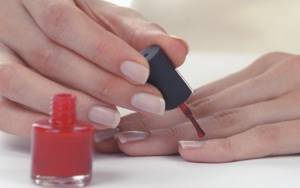
Fresh lemon can also be used. To do this, the fruit is cut in half. Nails are dipped into each half for 10 minutes. The procedure must be performed every other day, and for prevention - 2 times a week.

